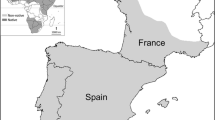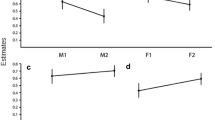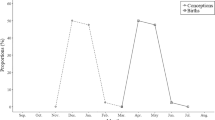Abstract
Some reproductive components of fitness (breeding times, litter size and the proportion of breeding females per year) of two feral populations of American minks in central Spain were investigated by means of direct observation from 2006 to 2010. The effects of prey availability were explored. Mating season was from February to March. Parturition dates did not differ between the two sites and pooled births took place between April (33.3%) and July (2.8%), peaking in May (40.3%). Mean litter size (the number of small cubs following their mother) was 3.43 ± 1.01 cubs (±SD; n = 30) with statistical significant differences between the two study sites. The strong seasonality in births and differences in litter size were related to prey availability (i.e. these are food-limited life-history traits), but in a complex non-linear fashion. A minimum value of prey abundance is necessary to breed. While litter size rises with prey abundance, there is a point where increasing prey did not result in an increase in litter size. Up to 75% of the females in the breeding pool reared cubs each year in both areas, which represents a somewhat high pool of breeding females. Delayed implantation is shorter than a month or does not exist in these populations. Such a short time-span seems to emerge because longer delays would have an important fitness cost to females. The breeding calendar and the litter size were similar to that reported previously from other areas.
Similar content being viewed by others
References
Angerbjörn, A., Arvidson, B., Norén, E., Strömgen, L., 1991. The effect of winter food on reproduction in the Artic fox, Alopex lagopus: a field experiment. J. Appl. Ecol. 60, 705–714.
Ben-David, M., 1997. Timing of reproduction in wild mink: influence of spawning Pacific salmon. Can J. Zool. 75, 376–382.
Blanckenhorn, W., 2010. The quantitative study of sexual and natural selection in the wild and in the laboratory. In: Kappeler, P. (Ed.), Animal behavior: Evolution and Mechanisms. Springer, Berlin.
Boutin, S., 1990. Food supplementation experiments with terrestrial vertebrates; problems, patterns and the future. Can. J. Zool. 68, 203–220.
Bravo, C., Bueno, R., 1999. Visón americano, Mustela vison Schreber, 1777. Galemys 11, 3–16.
Bronson, F.H., 1989. Mammalian Reproductive Biology. The University of Chicago Press, Chicago.
Burnham, K.P., Anderson, D.R., 2002. Model Selection and Multimodel Inference. Springer, New York.
Burnham, K.P., Anderson, D.R., Huyavaert, K.P., 2011. AIC model selection and multimodel inference in behavioral ecology: some background, observations, and comparisons. Behav. Ecol. Sociobiol. 65, 23–35.
Caro, S.P., Charmantier, A., Lambrechts, M.M., Blondel, J., Balthazart, J., Williams, T.D., 2009. Local adapation of timing of reproduction: females are in the driver’s seat. Funct. Ecol. 23, 172–179.
Chanin, P., 1983. Observations on two populations of feral mink in Devon, United Kingdom. Mammalia 47, 463–476.
Charnov, E.L., Ernest, S.K.M., 2006. The offspring/clutch size trade-off in mammals. Am. Nat. 167, 578–582.
Clutton-Brock, T.H., 1991. The Evolution of Parental Care. Princeton University Press, Princeton.
Conroy, J.W., Watt, J., Weeb, J.B., Jones, A., 2005. A Guide to Identification of Prey Remains in Otter Spraint. An Occasional Publication of the Mammal Society, no. 16. The Mammal Society, London.
Dotcherman, N.A., Jenkins, S.H., 2011. Developing multiple hypotheses in behavioral ecology. Behav. Ecol. Sociobiol. 65, 37–45.
Dunstone, N., 1993. The Mink. T and AD Poyser, London.
Elmeros, M., Hammershoj, M., 2006. Experimental evaluation of the reliability of placental scar counts in American mink (Mustela vison). Eur. J. Wildl. Res. 52, 132–135.
Ferguson, S.H., Virgl, J.A., Larivière, S., 1996. Evolution of delayed implantation and associated grade shifts in life history traits of North American carnivores. Écoscience 3, 7–17.
Forrest, J., Miller-Rushing, A.J., 2010. Toward a synthetic understanding of the role of phenology in ecology and evolution. Phil. Trans. R. Soc. B 365, 3101–3112.
Frankham, R., 1995. Effective population size/adult population size ratios in wildlife: a review. Genet. Res. 66, 95–107.
Frankham, R., Ballou, J.D., Briscoe, D.A., 2010. Introduction to Conservation Genetics. Cambridge University Press, Cambridge.
García, P., Mateos, I., Arévalo, V., 2009. Diurnal activity of the American mink (Neovison vison) in central Spain. Hystrix. Ital. J. Mammal. 20, 61–68.
García, P., Arévalo, V., Lizana, M., 2010. Characterisation of den sites of American mink Neovison vison in central Spain. Wildl. Biol. 16, 276–282.
García-Díaz, P., Arévalo, V., Lizana, M., 2011. Comparison of track and direct observation estimations for assessing abundance of the Eurasian otter, Lutra lutra. Folia Zool. 60, 37–42.
Gerell, R., 1971. Population studies of mink (Mustela vison) in southern Sweden. Oikos 21, 160–173.
Gibson, R.N., Ansell, A.D., Robb, L., 1993. Seasonal and annual variations in abundance and species composition of fish and macrocrustacean communities on a Scottish sandy beach. Mar. Ecol. Prog. Ser. 98, 89–105.
Goldman, B.D., 1999. The circadian timing system and reproduction in mammals. Steroids 64, 679–685.
Groffman, P., Baron, J., Blett, T., Gold, A., Goodman, I., Gunderson, L., Levinson, B., Palmer, M., Paerl, H., Peterson, G., LeRoy Poff, N., Rejeski, D., Reynolds, J., Turner, M., Weathers, K., Wiens, J., 2006. Ecological thresholds: the key to successful environmental management or animportant concept with no practical application? Ecosystems 9, 1–13.
Gurnell, J., Flowerdew, J.R., 2006. Live Trapping Small Mammals: A Practical Guide, Occasional Publications of the Mammal Society No. 3, 4th ed. The Mammal Society, London.
Hastie, T., Tibshirani, R., 1990. Generalized Additive Models. Chapman & Hall, London.
King, C.M., Powell, R.A., 2007. The Natural History of Weasels and Stoats, 2nd ed. Oxford University Press, Oxford.
Kruuk, H., Moorhouse, A., 1991. The spatial organization of otters (Lutra lutra) in Shetland. J. Zool. 224, 41–57.
Kruuk, H., Nolet, B., French, D., 1988. Fluctuations in numbers and activity of inshore demersal fishes in Shetland. J. Mar. Biol. Assoc. UK 68, 601–617.
Kruuk, H., Conroy, J.W.H., Moorhouse, A., 1991. Recruitment to a population of otters (Lutra lutra) in Shetland, in relation to fish abundance. J. App. Ecol. 28, 95–101.
Lack, D., 1948. The significance of litter-size. J. Anim. Ecol. 17, 45–50.
Larivière, S., 1999. Mustela vison. Mammal. Spec. 608, 1–9.
Macdonald, D.W., Harrington, L.A., 2003. The American mink: the triumph and tragedy of adaptation out of context. New Zeal. J. Zool. 30, 421–441.
Martin, T.E., 1987. Food as a limit on breeding birds: a life-history perspective. Ann. Rev. Ecol. Syst. 18, 453–487.
Miranda, R., Escala, M.C., 2002. Guíade identificación de restos óseos de los ciprínidos presentes en Espan˜a. Escamas, opérculos, cléitros y arcos faríngeos. Serie Zool. 28, 1–237.
Morris, D.W., 1998. State-dependent optimization of litter size. Oikos 83, 518–528.
Moyle, P.B., Cech, J.J., 2000. Fishes: An Introduction to Ichthyology, 4th ed. Prentice Hall, Upper Saddle River.
Nordström, M., Högmander, J., Laine, J., Nummelin, J., Laanetu, N., Korpimäki, E., 2003. Effects of feral mink removal on seabirds, waders and passerines on small islands of the Baltic Sea. Biol. Conserv. 109, 359–368.
Nowak, R.N., 1999. Walker’s Mammals of the World. The John Hopkins University, Baltimore.
Peay, S., 2003. Monitoring the white-clawed crayfish Austropotamobius p. pallipes. Conserving Natura 2000 Rivers, Monitoring Series No. 1. English Nature, Peterborough.
Pianka, E.R., 2000. Evolutionary ecology, 6th ed. Benjamin, Cummings.
R Development Core Team, 2010. R: A Language and Environment for Statistical Computing. R Foundation for Statistical Computing, Vienna, Austria. URL: https://doi.org/www.R-project.org/
Sidorovich, V.E., 1993. Reproductive plasticity of the American mink Mustela vison in Belarus. Acta Theriol. 38, 175–183.
Sinclair, A.R.E., 1974. The natural regulation of buffalo populations in East Africa: III. Population trends and mortality. East Afr. Wildl. J. 12, 185–200.
Sinclair, A.R.E., Fryxell, J.M., Caughley, G., 2006. Wildlife Ecology, Conservation and Management, 2nd ed. Blackwell Publishing, Oxford.
Sundqvist, C., Amador, A.G., Bartke, A., 1989. Reproduction and fertility in the mink (Mustela vison). J. Reprod. Fertil. 85, 413–441.
Sutherland, W.J. (Ed.), 2006. Ecological Census Techniques. A Handbook. , 2nd ed. Cambridge University Press, Cambridge.
Thom, M., Johnson, D.D.P., Macdonald, D.W., 2004. The evolution and maintenance of delayed implantation in the Mustelidae. Evolution 58, 175–183.
Thomas, D.W., Blondel, J., Perret, P., Lambrechts, M.M., Speakman, J.R., 2001. Energetic and fitness costs of mismatching resource supply and demand in seasonally breeding birds. Science 291, 2598–2600.
Trillmich, F., 2010. Parental care: adjustments to conflict and cooperation. In: Kappeler, P. (Ed.), Animal Behavior: Evolution and Mechanisms. Springer, Berlin.
Visser, M.E., Caro, S.P., Oers, K. van, Schaper, S.V., Helm, B., 2010. Phenology, seasonal timing and circannual rhythms: towards a unified framework. Phil. Transc. R. Soc. B 365, 3113–3127.
White, T.C.R., 1978. The importance of relative shortage of food in animal ecology. Oecologica 33, 71–86.
Wolff, J.O., 1997. Population regulation in mammals: an evolutionary perspective. J. Anim. Ecol. 66, 1–13.
Wolff, J.O., Shermann, P.W. (Eds.), 2007. Rodent Societies: An Ecological and Evolutionary Perspective. The University of Chicago Press, Chicago.
Wood, S.N., 2001. Partially specified ecological models. Ecol. Monogr. 71, 1–25.
Yamaguchi, N., Sarno, R.J., Johnson, W.E., O’Brien, S.J., Macdonald, D.W., 2004. Multiple paternity and reproductive tactics of free-ranging American minks, Mustela vison. J. Mammal. 85, 432–439.
Author information
Authors and Affiliations
Corresponding author
Rights and permissions
About this article
Cite this article
García-Díaz, P., Lizana, M. Reproductive aspects of American minks (Neovison vison) in central Spain: Testing the effects of prey availability. Mamm Biol 78, 111–117 (2013). https://doi.org/10.1016/j.mambio.2012.11.002
Received:
Accepted:
Published:
Issue Date:
DOI: https://doi.org/10.1016/j.mambio.2012.11.002




